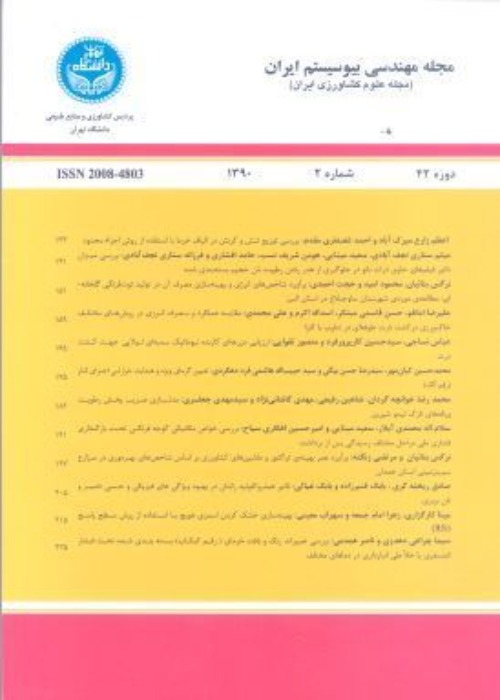Modeling the effect of different oscillation angles on the oscillatory tine performance using Discrete Element Method
Author(s):
Article Type:
Research/Original Article (دارای رتبه معتبر)
Abstract:
Interaction between soil and machine is essential challenge for researchers, developers, designers and manufacturers of agricultural machineries. Modeling of tillage equipment is an important Engineering work. However, interaction modeling is a complex process due to three-dimensional changes in soil, nonlinear soil behavior phenomenon and soil flow quality in connection area between the soil and tool and the dynamic effects of equipment. Correct simulation of the interaction of soil is the key point for the optimization of tillage tools and can eliminate required field tests with high costs. The purpose of this study is to develop a three-dimensional model of a vibrating subsoiler using discrete element method, simulation frequency and oscillation angle on the performance of vibration subsoiler and determining different parameters affecting the simulation results. The information from model simulation will be useful for the design and optimization of vibrating subsoiler. For modeling soil mass as a granular material, the computer program PFC3D. Blade was moved with angular and transition speed in the positive x-axis direction. For non-vibrating blade only included transition speed and for vibration blade in addition to transition speed, angular velocity was also defined. Working depth was 38 cm and blade speed of 0.89 meters per second was defined. To evaluate the effect of vibration angle on vibrating subsoiler different vibration of 27, 16, 8, zero,-14.5,-22.5 degrees in frequency of 4.9 Hz and amplitude of ± 69 amplitude was tested by simulation. In all vibration tests in comparison with non-vibrating,with Increasing vibration angle (positive and negative), the amount of vertical displacement of blade increased which caused more soil rupture. Simulation results showed that the rate of boundary work, kinetic energy and friction work at positive angles were more than negative vibration angles. With increasing negative angle boundary work and friction work significantly decreased. Changing the angle from -22.5 to 27 degrees decreased average bond energy of particles.
Keywords:
Language:
Persian
Published:
Iranian Journal of Biosystems Engineering, Volume:49 Issue: 2, 2018
Pages:
181 to 194
magiran.com/p1851802
دانلود و مطالعه متن این مقاله با یکی از روشهای زیر امکان پذیر است:
اشتراک شخصی
با عضویت و پرداخت آنلاین حق اشتراک یکساله به مبلغ 1,390,000ريال میتوانید 70 عنوان مطلب دانلود کنید!
اشتراک سازمانی
به کتابخانه دانشگاه یا محل کار خود پیشنهاد کنید تا اشتراک سازمانی این پایگاه را برای دسترسی نامحدود همه کاربران به متن مطالب تهیه نمایند!
توجه!
- حق عضویت دریافتی صرف حمایت از نشریات عضو و نگهداری، تکمیل و توسعه مگیران میشود.
- پرداخت حق اشتراک و دانلود مقالات اجازه بازنشر آن در سایر رسانههای چاپی و دیجیتال را به کاربر نمیدهد.
In order to view content subscription is required
Personal subscription
Subscribe magiran.com for 70 € euros via PayPal and download 70 articles during a year.
Organization subscription
Please contact us to subscribe your university or library for unlimited access!


